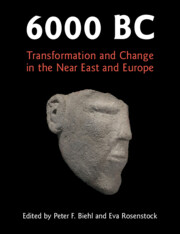69 results

Environmental Foundations to the Rise of Early Civilisations in China
-
- Published online:
- 09 December 2024
- Print publication:
- 09 January 2025
-
- Element
-
- You have access
- Open access
- HTML
- Export citation

Learning for Environmental Governance
- Insights for a More Adaptive Future
-
- Published online:
- 22 April 2024
- Print publication:
- 16 May 2024
-
- Element
- Export citation
From Mind to Matter: Patterns of Innovation in the Archaeological Record and the Ecology of Social Learning
-
- Journal:
- American Antiquity / Volume 89 / Issue 1 / January 2024
- Published online by Cambridge University Press:
- 12 December 2023, pp. 19-36
- Print publication:
- January 2024
-
- Article
-
- You have access
- Open access
- HTML
- Export citation
3 - Evolution of the Antarctic Continent and Its Ice Sheet
-
-
- Book:
- The Cambridge History of the Polar Regions
- Published online:
- 24 March 2023
- Print publication:
- 11 May 2023, pp 55-78
-
- Chapter
- Export citation
6 - The Norse Settlement of Greenland
-
-
- Book:
- The Cambridge History of the Polar Regions
- Published online:
- 24 March 2023
- Print publication:
- 11 May 2023, pp 129-152
-
- Chapter
- Export citation
Habitat severity characteristics structure soil communities at regional and local spatial scales along the Antarctica Peninsula
-
- Journal:
- Antarctic Science / Volume 35 / Issue 2 / April 2023
- Published online by Cambridge University Press:
- 01 March 2023, pp. 103-119
-
- Article
-
- You have access
- Open access
- HTML
- Export citation
Developing adaptive capacity and preparedness in clinical and translational science
- Part of
-
- Journal:
- Journal of Clinical and Translational Science / Volume 7 / Issue 1 / 2023
- Published online by Cambridge University Press:
- 28 February 2023, e51
-
- Article
-
- You have access
- Open access
- HTML
- Export citation
The Possession Islands Ross Sea Antarctica: A history of exploration and scientific endeavour at a Ross Sea archipelago since the first landing in 1841
-
- Journal:
- Polar Record / Volume 59 / 2023
- Published online by Cambridge University Press:
- 27 February 2023, e13
-
- Article
- Export citation
Changing Svalbard: Tracing interrelated socio-economic and environmental change in remote Arctic settlements – CORRIGENDUM
-
- Journal:
- Polar Record / Volume 58 / 2022
- Published online by Cambridge University Press:
- 27 February 2023, e43
-
- Article
-
- You have access
- Open access
- HTML
- Export citation
THE ACCURACY AND PRECISION OF SMALL-SIZED MODERN WOOD SAMPLES ANALYZED AT THE CHRONOS 14CARBON-CYCLE FACILITY
-
- Journal:
- Radiocarbon / Volume 65 / Issue 2 / April 2023
- Published online by Cambridge University Press:
- 21 February 2023, pp. 561-571
- Print publication:
- April 2023
-
- Article
- Export citation

The Rural Landscapes of Archaic Cyprus
- An Archaeology of Environmental and Social Change
-
- Published online:
- 18 February 2023
- Print publication:
- 15 December 2022
How to use natural history collections to resurrect information on historical parasite abundances
- Part of
-
- Journal:
- Journal of Helminthology / Volume 97 / 2023
- Published online by Cambridge University Press:
- 12 January 2023, e6
-
- Article
-
- You have access
- Open access
- HTML
- Export citation
2 - Reassessing the “Land” of Landscape
- from Part I - On Environs
-
- Book:
- The Rural Landscapes of Archaic Cyprus
- Published online:
- 18 February 2023
- Print publication:
- 15 December 2022, pp 43-75
-
- Chapter
- Export citation
7 - Eruptions, Emissions, and Enigmas: From Fuming Volcanic Vents to Mass Extinction Events
-
-
- Book:
- Enigmas
- Published online:
- 01 September 2022
- Print publication:
- 18 August 2022, pp 148-178
-
- Chapter
- Export citation
Changing Svalbard: Tracing interrelated socio-economic and environmental change in remote Arctic settlements
- Part of
-
- Journal:
- Polar Record / Volume 58 / 2022
- Published online by Cambridge University Press:
- 10 August 2022, e23
-
- Article
-
- You have access
- Open access
- HTML
- Export citation
1 - Approaching Environmental Violence
-
- Book:
- Environmental Violence
- Published online:
- 14 July 2022
- Print publication:
- 28 July 2022, pp 1-24
-
- Chapter
- Export citation
1 - Co-production between Indigenous Knowledge and Science: Introducing a Decolonized Approach
- from Introduction
-
-
- Book:
- Resilience through Knowledge Co-Production
- Published online:
- 02 June 2022
- Print publication:
- 30 June 2022, pp 3-24
-
- Chapter
- Export citation

6000 BC
- Transformation and Change in the Near East and Europe
-
- Published online:
- 30 April 2022
- Print publication:
- 05 May 2022
Verbal folklore in contemporary southern Italy: a not-so-distant mirror of cultural and environmental change
-
- Journal:
- Modern Italy / Volume 27 / Issue 2 / May 2022
- Published online by Cambridge University Press:
- 21 February 2022, pp. 119-135
- Print publication:
- May 2022
-
- Article
-
- You have access
- Open access
- HTML
- Export citation
1 - Fluvial Lowlands and the Environment
-
- Book:
- Flooding and Management of Large Fluvial Lowlands
- Published online:
- 04 November 2021
- Print publication:
- 25 November 2021, pp 1-8
-
- Chapter
- Export citation

